语言学简明教程Chapter_5
英语语言学Chapter 5_semantics
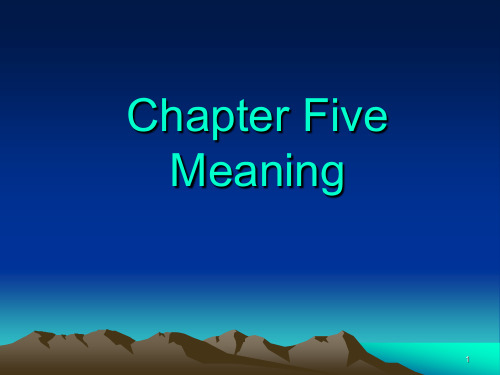
5. Sense & Reference
• Sense and reference are the two terms often encountered in the study of word meaning. They are two related but different aspects of meaning. • Sense– the inherent meaning of the linguistic form. It is the collection of all the features of the linguistic form. • Reference: What a linguistic form refers to in the real, physical world.
18
„Colorful‟ meaning
• Commendatory • tough-minded • resolute, firm • shrewd • childlike • wiseman • man of usual talent • portly, stout, solid, plum • slender, slim • • • • • • • • • Derogatory ruthless obstinate sly, crafty childish wiseguy freak fleshy, fat, tubby lean, skinny, lanky, weedy, scraggy
27
Differences:
• (1) • (2) • (3) linguistic forms having the same sense may have different references in different situations. e.g. I was once bitten by a dog. Mind you. There is a dog over there. Sometimes linguistic forms with the same reference might differ in sense. “朝阳” & “夕阳” “主任” &
语言学教案Chapter 5 Meaning
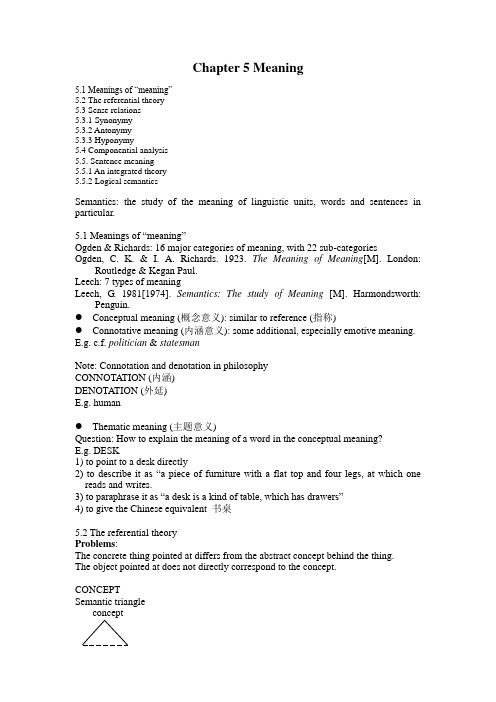
Chapter 5 Meaning5.1 Meanings of “meaning”5.2 The referential theory5.3 Sense relations5.3.1 Synonymy5.3.2 Antonymy5.3.3 Hyponymy5.4 Componential analysis5.5. Sentence meaning5.5.1 An integrated theory5.5.2 Logical semanticsSemantics: the study of the meaning of linguistic units, words and sentences in particular.5.1 Meanings of “meaning”Ogden & Richards: 16 major categories of meaning, with 22 sub-categories Ogden, C. K. & I. A. Richards. 1923. The Meaning of Meaning[M]. London: Routledge & Kegan Paul.Leech: 7 types of meaningLeech, G. 1981[1974]. Semantics: The study of Meaning [M]. Harmondsworth: Penguin.●Conceptual meaning (概念意义): similar to reference (指称)●Connotative meaning (内涵意义): some additional, especially emotive meaning.E.g. c.f. politician & statesmanNote: Connotation and denotation in philosophyCONNOTATION (内涵)DENOTATION (外延)E.g. human●Thematic meaning (主题意义)Question: How to explain the meaning of a word in the conceptual meaning?E.g. DESK1) to point to a desk directly2) to describe it as “a piece of furniture with a flat top and four legs, at which one reads and writes.3) to paraphrase it as “a desk is a kind of table, which has drawers”4) to give the Chinese equivalent 书桌5.2 The referential theoryProblems:The concrete thing pointed at differs from the abstract concept behind the thing.The object pointed at does not directly correspond to the concept.CONCEPTSemantic triangleconceptword thingC.f. Sense & reference1) Sense: the abstract properties of an entity——concept ——connotation Reference: the concrete entities having these entities ——denotation2) Every word has a sense, but not every word has a reference.E.g. grammatical words like but, if, and5.3 Sense relations●Sense●ReferenceThree kinds of sense relations: sameness relation, oppositeness relation, and inclusiveness relation5.3.1 SynonymySYNONYMY: the sameness relation●Stylistic differenceE.g. Little Tom ___________ a toy bear. c.f. buy & purchase●Connotative difference.E.g. “I’m thrifty. You are economical. And he is stingy.”●Dialectical differenceE.g. c.f. autumn & fall5.3.2 AntonymyAntonymy: the oppositeness relation(1) Gradable antonymyE.g. good: bad, long: short, big: smallgradable---comparative and superlative degree; lexicalizationE.g. good & badgraded against different norms---no absolute criterionE.g. c.f. a big car & a small planeone member of a pair, usually the term for the higher degree, serves as the cover term E.g. How old are you?C.f. Unmarked & marked●Unmarked: the term is more often used●Marked: the term is less used, odd, or unusual(2) Complementary antonymyE.g alive:dead, male:femaleNOTE 1: Not only the assertion of one means the denial of the other, the denial of one also means the assertion of the other.NOTE 2: No comparative or superlative degrees are allowed.E.g. alive, dead, 半死不活*John is more dead than Mary.C.f. John is more mad than stupid.C.f. Gradable and complementary1. The difference between the gradable and the complementary is somewhat similar tothat between the contrary and the contradictory.In logic, a proposition is the contrary of another if it is impossible for both to true, or false.E.g. The coffee is hot.The coffee is cold.A proposition is the contradictory of another if it is impossible for both to be true, orfalse.E.g. This is a male cat.This is a female cat.a b a bgradable complementary2. The norm in complementary is absolute.E.g. male & female3. There is no cover term for the two members of a pair.E.g. Is it a boy or a girl?*How male is it?Exception: true & false (Pp 167)(3) Converse antonymyE.g. buy: sell, lend: borrowX buys something from Y. == Y sells something to X.RELATIONAL OPPOSITES5.3.3 HyponymyHYPONYMYSUPERORDINATEHYPONYMSCO-HYPONYMSflowerrose peony jasmine chrysanthemum tulip violet carnationAUTO-HYPONMYlivingplant animalbird fish insect animalhuman animaltiger lion elephant …5.4 Componential analysisSEMANTIC FEATURES/SEMANTIC COMPONENTS: semantic units smaller than the meaning of a word. (Pp 170)E.g. boy: HUMAN, YOUNG, MALEwoman: HUMAN, ADULT, FEMALEYOUNG: ~ADULTFEMALE: ~MALEE.g. father = PARENT (x, y) & MALE (x)mother = PARENT (x, y) & ~MALE (x)son = CHILD (x, y) & MALE (x)die = BECOME (x, (~ALIVE(x)))kill = CAUSE (x, (BECOME (y, (~ALIVE (y)))))murder = INTEND (x, (CAUSE (x, (BECOME (y, (~ALIVE (y)))))))➢Synonyms: words or expressions with the same semantic componentsE.g. bachelor, unmarried man: HUMAN, ADULT, UNMARRIED➢Antonyms: words with contrasting semantic componentsE.g. cold & hot, give & take➢Hyponyms: words which have all the semantic components of anotherE.g. boy & girl are hyponyms of childSense relations between sentences:E.g.1.a. * John killed Bill but Bill didn’t die.b. * John killed Bill but he was not the cause of Bill’s death.c. * John murdered Bill without intending to.EntailmentE.g. a. John killed Bill.b. Bill died.Difficulties1) Polysemous words will have different sets of semantic components.2) The difference between the semantic components differs.C.f. MALE and FEMALE (absolute) & ADULT and YOUNG (relative)boy and man (clear-cut)& girl and woman (vague)3) There may be words whose semantic components are difficult to ascertain. Question: How to express the semantic features?METALANGUAGE (原语言): a language used for talking about another language 5.5. Sentence meaning1) The sentence meaning is not merely a sum of word meaning, and it is related to word order.E.g. a. The man chased the dog.b. The dog chased the man.2) Sentences have thematic meaning.E.g. a. I’ve already seen that film.b. That film I’ve already seen.3) The sentence meaning is connected with its syntactic structure.E.g. The son of Pharaoh’s daughter is the daughter of Pharaoh’s son.5.5.1 An integrated theoryPrinciple of COMPOSITIONALITYsystematic informationgrammatical classificationdictionary idiosyncratic information Semantic theory semantic informationprojection rules●Dictionary: to provide the grammatical classification and semantic information ofwords➢Grammatical classificationGrammatical markers/syntactic markersSystematic information✧Systemic part —Semantic markers: (Male), (Female), (Human), (Animal)✧Idiosyncratic information —Distinguishers(辨义成分)E.g. bachelora. [who has never married];b. [young knights serving under the standard of another knight];c. [who has the first or lowest academic degree];d. [young fur seal when without a mate during the breeding time].●Projection rules: responsible for combining the meanings of words togetherSNP VPDet N V NPthe man hits Det Nthe Adj Ncolorful ballSelection restrictionsProblems1. The distinction between semantic marker and distinguisher is not very clear.E.g. (Young)2. The collocation of words may not be accounted for by grammatical markers, semantic markers or selection restrictions.E.g. a. He said hello to the nurse and she greeted back.b. My cousin is a male nurse.c. ? My cousin is a female nurse.3. The use of semantic markers like (Human), (Male) and (Adult), is elements of an artificial meta-language.5.5.2 Logical semanticssentence meaningPREPOSITIONAL LOGIC(命题逻辑)/ PROPOSITIONAL CALCULUS(命题演算)/ SENTENTIAL CALCULUS(句子演算):proposition≈sentence meaningTruth value: truth or falsePredicate logic (Pp 180)p (simple proposition)one-place connective: negation ~or ﹁two-place connective: conjunction &disjunction ∨implicationequivalence ≡orConnective conjunction: similar to the English “and”Connective disjunction: similar to the English “or”Connective implication/conditional implication: corresponds to the English “if…then”Connective equivalence/bicond itional: corresponds to “iff…then”C.f. Antonyms & “not”●With complementary antonyms, the denial of one is the assertion of the other.●With gradable, that is not necessarily the case.E.g. John isn’t old.John is old.C.f. Conjunction & “and”●ConjunctionE.g. He missed the train and arrived late.●“And”E.g. He arrived late and missed the train.*He missed the train and arrived late.C.f. Implication & “if…then”●ImplicationE.g. If he is an Englishman, he speaks English.If snow is white, grass is green.E.g. If snow is black, grass is green.●“If…then”E.g.? If snow is white, grass is green.*If snow is black, grass is green.In sum, propositional logic, concerned with the semantic relation between propositions, treats a simple proposition as an unanalyzed whole.E.g. All men are rational.Socrates is a man.Therefore, Socrates is rational.PREDICATE LOGIC/PREDICATE CALCCULUS studies the internal structure of simple propositions.Question: How to analyze Socrates is a man?Argument (主目): a term which refers to some entity about which a statement is being madePredicate (谓词): a term which ascribes some property, or relation, to the entity, or entities, referred toSocrates is the argument, and man is the predicate.Token: M(s)Note: A simple proposition is seen as a function (函数) of its argument. The truth value of a proposition varies with the argument.M(s) =1, M(c) =0E.g. John loves Mary.L (j, m)John gave Mary a book. G (j, m, b)kill: CAUSE (x, (BECOME (y, (~ALIVE (y)))))C (x, (B (y, (~A (y)))))All men are rational.1. All is the universal quantifier and symbolized by an upturned A—∀in logic.2. The argument men does not refer to any particular entity, which is known as avariable and symbolized as x, y.Notation: ∀x (M(x) R(x))“For all x, it is the case that, if x is a man, then x is rational.”Some men are clever.Some is the existential quantifier and symbolized by a reversed E—∃Notation: ∃x (M(x) & C(x))C.f. Universal quantifier & existential quantifier1.Quantifiers2.Implication connectiveE.g.All men are rational.There is no man who is not rational.Notation: ∀x (M(x) R(x)) ≡~∃x(M(x) & ~R(x))(1) ∀x(P(x))≡~∃x(~P(x))~∀x (P(x))≡∃x (~P(x))∃x (P(x)) ≡~∀x (~P(x))~∃x (P(x)) ≡∀x (~P(x))(2) ∀x(M(x) R(x))M(s)∴R(s)(3) ∀x(M(x)) R(x))R(s)∴R(s)(4) ∃x (M(x) & C(x))M(s)∴C(s)。
chapter5semantics语言学
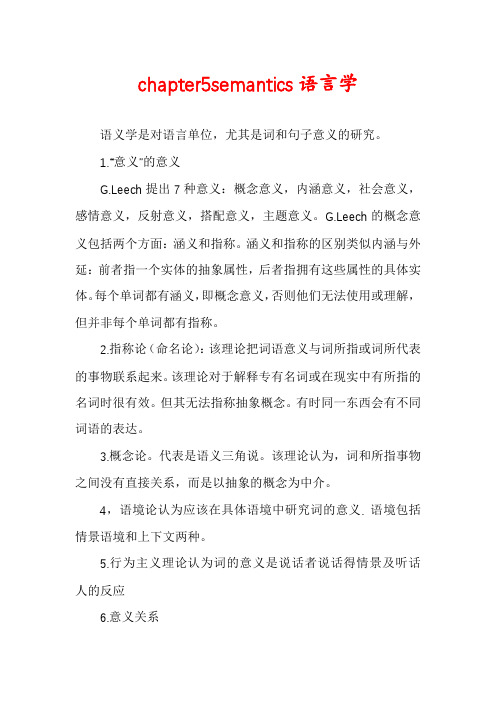
chapter5semantics语言学语义学是对语言单位,尤其是词和句子意义的研究。
1.“意义”的意义G.Leech提出7种意义:概念意义,内涵意义,社会意义,感情意义,反射意义,搭配意义,主题意义。
G.Leech的概念意义包括两个方面:涵义和指称。
涵义和指称的区别类似内涵与外延:前者指一个实体的抽象属性,后者指拥有这些属性的具体实体。
每个单词都有涵义,即概念意义,否则他们无法使用或理解,但并非每个单词都有指称。
2.指称论(命名论):该理论把词语意义与词所指或词所代表的事物联系起来。
该理论对于解释专有名词或在现实中有所指的名词时很有效。
但其无法指称抽象概念。
有时同一东西会有不同词语的表达。
3.概念论。
代表是语义三角说。
该理论认为,词和所指事物之间没有直接关系,而是以抽象的概念为中介。
4,语境论认为应该在具体语境中研究词的意义. 语境包括情景语境和上下文两种。
5.行为主义理论认为词的意义是说话者说话得情景及听话人的反应6.意义关系词语词之间的主要意义关系:相同关系,相反关系,包含关系a.同义关系。
完全同义关系很少,所谓的同一都依赖语境,并总在某方面不同。
(方言,内涵,文体等)b.反义关系主要包括:等级反义关系,互补反义关系,关系反义关系。
1)等级反义的特点:第一,否定一方并不必然是肯定另一方,还有中间状态;第二,没有绝对评判标准,标准随对象而改变。
第三,通常用其中表示较高程度的词来覆盖整个量级。
覆盖性词被称为“无标记的”,即一般性的;被覆盖词被称为“有标记的”,即特殊的。
一般使用覆盖性词语。
一旦使用被覆盖词语,表示有某种特殊的、不一般的情况。
第四,可用very修饰,可有比较级最高级2)互补反义关系,第一,肯定一方意味着否定另一方。
反之亦然。
第二,不用very修饰,没有比较级最高级。
第三,评判标准绝对。
没有覆盖性词语3)关系(反向)反义关系,表现两个实体间的一种反向关系,不构成肯否定对立。
一个预设着另一个的存在。
语言学整理的资料Chapter 5 semantics
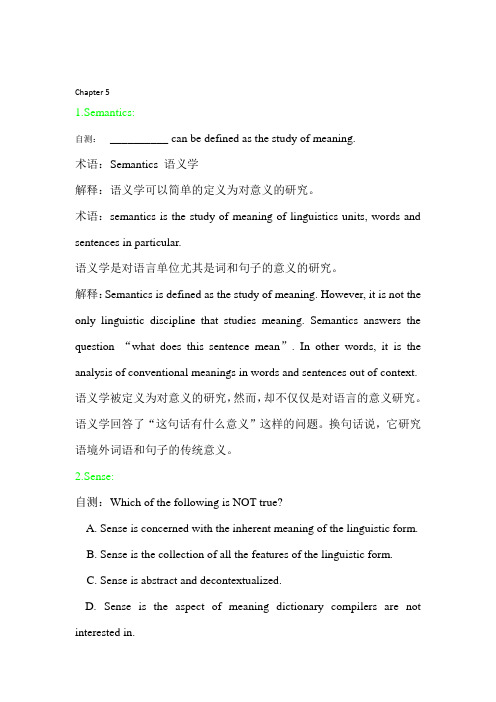
Chapter 51.Semantics:自测: __________ can be defined as the study of meaning.术语:Semantics 语义学解释:语义学可以简单的定义为对意义的研究。
术语:semantics is the study of meaning of linguistics units, words and sentences in particular.语义学是对语言单位尤其是词和句子的意义的研究。
解释:Semantics is defined as the study of meaning. However, it is not the only linguistic discipline that studies meaning. Semantics answers the question “what does this sentence mean”. In other words, it is the analysis of conventional meanings in words and sentences out of context. 语义学被定义为对意义的研究,然而,却不仅仅是对语言的意义研究。
语义学回答了“这句话有什么意义”这样的问题。
换句话说,它研究语境外词语和句子的传统意义。
2.Sense:自测:Which of the following is NOT true?A. Sense is concerned with the inherent meaning of the linguistic form.B. Sense is the collection of all the features of the linguistic form.C. Sense is abstract and decontextualized.D. Sense is the aspect of meaning dictionary compilers are not interested in.术语:Sense 涵义解释:涵义指一个实体的抽象属性。
新编简明英语语言学Chapter5Semantics语义学
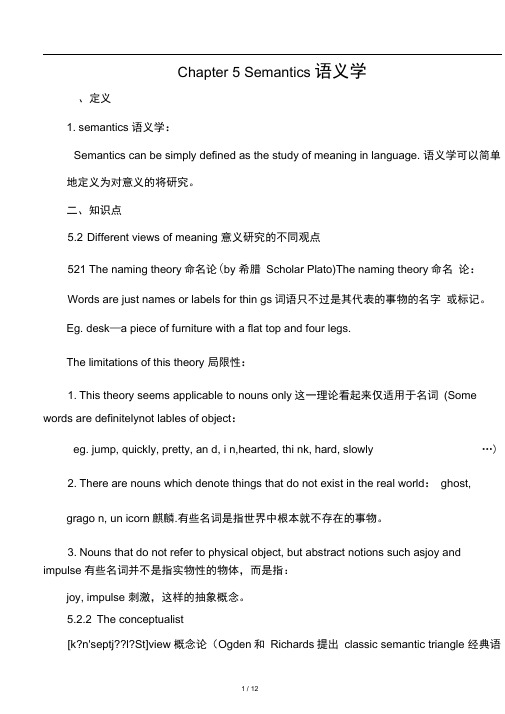
Chapter 5 Semantics 语义学、定义1. semantics 语义学:Semantics can be simply defined as the study of meaning in language. 语义学可以简单地定义为对意义的将研究。
二、知识点5.2 Different views of meaning 意义研究的不同观点521 The naming theory命名论(by 希腊Scholar Plato)The naming theory命名论:Words are just names or labels for thin gs词语只不过是其代表的事物的名字或标记。
Eg. desk—a piece of furniture with a flat top and four legs.The limitations of this theory 局限性:1. This theory seems applicable to nouns only这一理论看起来仅适用于名词(Some words are definitelynot lables of object:eg. jump, quickly, pretty, an d, i n,hearted, thi nk, hard, slowly …)2. There are nouns which denote things that do not exist in the real world: ghost,grago n, un icorn麒麟.有些名词是指世界中根本就不存在的事物。
3. Nouns that do not refer to physical object, but abstract notions such asjoy and impulse有些名词并不是指实物性的物体,而是指:joy, impulse 刺激,这样的抽象概念。
胡壮麟-语言学教程修订版-课堂笔记和讲义精选Chapter--(5)
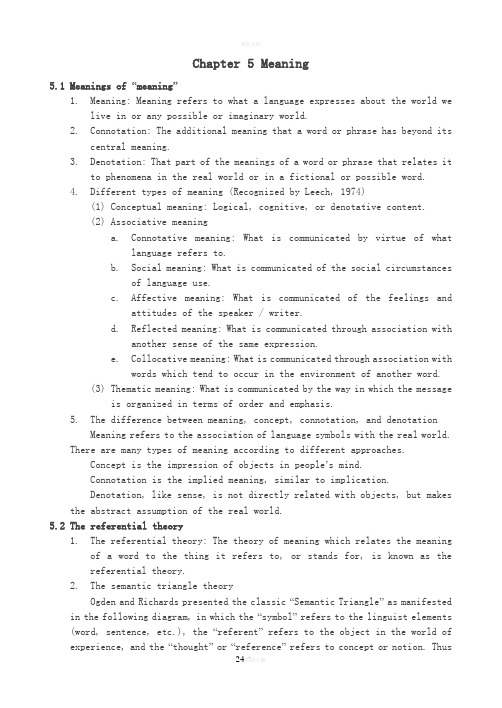
Chapter 5 Meaning5.1 Meanings of “meaning”1. Meaning: Meaning refers to what a language expresses about the world welive in or any possible or imaginary world.2. Connotation: The additional meaning that a word or phrase has beyond itscentral meaning.3. Denotation: That part of the meanings of a word or phrase that relates itto phenomena in the real world or in a fictional or possible word.4. Different types of meaning (Recognized by Leech, 1974)(1) Conceptual meaning: Logical, cognitive, or denotative content.(2) Associative meaninga. Connotative meaning: What is communicated by virtue of whatlanguage refers to.b. Social meaning: What is communicated of the social circumstancesof language use.c. Affective meaning: What is communicated of the feelings andattitudes of the speaker / writer.d. Reflected meaning: What is communicated through association withanother sense of the same expression.e. Collocative meaning: What is communicated through association withwords which tend to occur in the environment of another word.(3) Thematic meaning: What is communicated by the way in which the messageis organized in terms of order and emphasis.5. The difference between meaning, concept, connotation, and denotationMeaning refers to the association of language symbols with the real world.There are many types of meaning according to different approaches.Concept is the impression of objects in people’s mind.Connotation is the implied meaning, similar to implication.Denotation, like sense, is not directly related with objects, but makes the abstract assumption of the real world.5.2 The referential theory1. The referential theory: The theory of meaning which relates the meaningof a word to the thing it refers to, or stands for, is known as thereferential theory.2. The semantic triangle theoryOgden and Richards presented the classic “Semantic Triangle”as manifested in the following diagram, in which the “symbol”refers to the linguist elements (word, sentence, etc.), the “referent” refers to the object in the world of experience, and the “thought”or “reference”refers to concept or notion. Thusthe symbol of a word signifies “things” by virtue of the “concept,”associated with the form of the word in the mind of the speaker of the language. The concept thus considered is the meaning of the word. The connection (represented witha dotted line) between symbol and referent is made possible only through“concept.”Concept / notionThought / reference----------------------Symbol objectWord stands for realitySignifier referentCode signified5.3 Sense relations5.3.1 SynonymySynonymy is the technical name for the sameness relation.5.3.2 AntonymyAntonymy is the name for oppositeness relation. There are three subtypes: gradable, complementary and converse antonymy.1. Gradable antonymyGradable antonymy is the commonest type of antonymy. They are mainly adjectives, e.g. good / bad, long / short, big / small, etc.2. Complementary antonymyThe members of a pair in complementary antonymy are complementary to each other. That is, they divide up the whole of a semantic filed completely.Not only the assertion of one means the denial of the other, the denialof one also means the assertion of the other, e.g. alive / dead, hit / miss,male / female, boy / girl, etc.3. Converse antonymyConverse antonyms are also called relational opposites. This is a special type of antonymy in that the members of a pair do not constitutea positive-negative opposition. They show the reversal of a relationshipbetween two entities, e.g. buy / sell, parent / child, above / below,etc.5.3.3 HyponymyHyponymy involves us in the notion of meaning inclusion. It is a matter of class membership. That is to say, when x is a kind of y, thelower term x is the hyponym, and the upper term y is the superordinate.Two or more hyponyms of the same one superordinate are calledco-hyponyms, e.g. under flower, there are peony, jasmine, tulip, violet,rose, etc., flower is the superordinate of peony, jasmine,etc., peonyis the hyponym of flower,and peony, jasmine, tulip, violet, rose, etc.are co-hyponyms.5.4 Componential analysisComponential analysis defines the meaning of a lexical element in terms of semantic components. That is, the meaning of a word is not an unanalyzable whole. It may be seen as a complex of different semantic features. There are semantic units smaller than the meaning of a word. E.g.Boy: [+human][-adult][+male]Girl: [+human][-adult][-male]Son: child (x, y) & male (x)Daughter: child (x, y) & -male (x)Take: cause (x, (have (x, y)))Give: cause (x, (-have (x, y)))5.5 Sentence meaning5.5.1 An integrated theory1. Compositionality: A principle for sentence analysis, in which themeaning of a sentence depends on the meanings of the constituentwords and the way they are combine.2. Selection restrictions: Restrictions on the choice of individuallexical units in construction with other units. E.g. the wordbreathe will typically select an animate subject (boy, man, woman,etc.) not an abstract or an inanimate (table, book, etc.). The boywas still breathing. The desk was breathing.5.5.2 Logical semantics1. Prepositional logic / prepositional calculus / sentential calculus:Prepositional logic is the study of the truth conditions forpropositions: how the truth of a composite proposition isdetermined by the truth value of its constituent propositions andthe connections between them.2. Predicate logic / predicate calculus: Predicate logic studies theinternal structure of simple propositions.。
新编简明英语语言学 Chapter 5 Semantics 语义学

Chapter 5 Semantics 语义学一、定义1. semantics语义学: Semantics can be simply defined as the study of meaning in language. 语义学可以简单地定义为对意义的将研究。
二、知识点5.2 Different views of meaning意义研究的不同观点5.2.1 The naming theory命名论(by希腊Scholar Plato)The naming theory命名论: Words are just names or labels for things.词语只不过是其代表的事物的名字或标记。
Eg. desk—a piece of furniture with a flat top and four legs.The limitations of this theory局限性:1. This theory seems applicable to nouns only.这一理论看起来仅适用于名词(Some words are definitelynot lables of object: eg. jump, quickly, pretty, and, in, hearted, think, hard, slowly…)2. There are nouns which denote things that do not exist in the real world: ghost, gragon, unicorn麒麟. 有些名词是指世界中根本就不存在的事物。
3. Nouns that do not refer to physical object, but abstract notions such as joy and impulse. 有些名词并不是指实物性的物体,而是指:joy, impulse刺激,这样的抽象概念。
英语语言学概论 Chapter 5 Morphology(形态学)
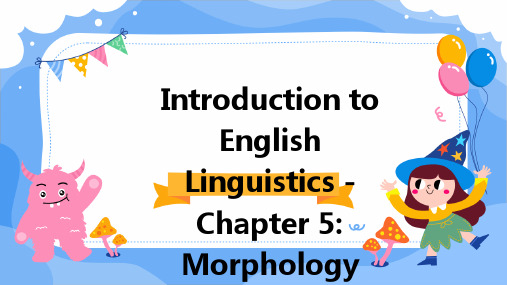
"basketball" (combination of "basket" and "ball")
"mother-in-law" (combination of "mother" and "in-law")
"blackboard" (combination of "black" and "board")
• Inflectional Variation: Morphology also deals with the inflectional variation of words, which refers to the changes in word form that indicate grammatical function or category. Understanding inflectional morphology is crucial for proper sentence structure and grammar.
Grammar
目录
• The Relationship between Morphology and Vocabulary
01
Morphological Overview
Definition and Purpose
Definition: Morphology is the study of the structure and forms of words in a language. It focuses on the internal composition of words, including the derivation of new words from existing words (derivational morphology) and the modification of words through the addition or deletion of affixes (inflectional morphology).
语言学Chapter 5 Meaning (revised)
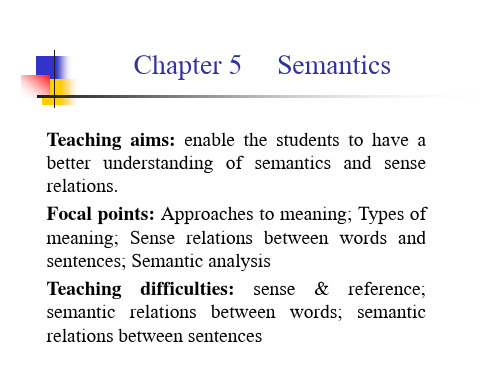
Q3: Types of meaning
3.1 Sense & reference 涵义和指称、系统意 义和外指意义 Sense-----the inherent meaning of the linguistic form independent of situational context. It’s the aspect of meaning dictionary compilers are interested in. It is concerned with the intra-linguistic relations. It’s abstract and de-contextualized.
பைடு நூலகம்
The term semantics is a recent addition to the English language. It has only a history of a little over a hundred years. 1894 it was introduced in a paper entitled “Reflected meanings:a point in semantics” 1897 Breal first used it as the science of meaning. 1900 its English version came out 1980s semantics began to be introduced into China One of the most famous books on semantics is The Meaning of Meaning published in 1923.
英语语言学概论第五章笔记
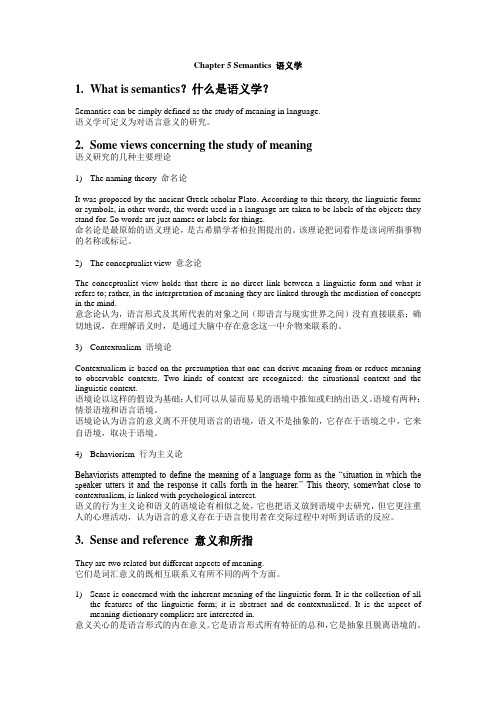
Chapter 5 Semantics 语义学1.What is semantics?什么是语义学?Semantics can be simply defined as the study of meaning in language.语义学可定义为对语言意义的研究。
2.Some views concerning the study of meaning语义研究的几种主要理论1)The naming theory 命名论It was proposed by the ancient Greek scholar Plato. According to this theory, the linguistic forms or symbols, in other words, the words used in a language are taken to be labels of the objects they stand for. So words are just names or labels for things.命名论是最原始的语义理论,是古希腊学者柏拉图提出的。
该理论把词看作是该词所指事物的名称或标记。
2)The conceptualist view 意念论The conceptualist view holds that there is no direct link between a linguistic form and what it refers to; rather, in the interpretation of meaning they are linked through the mediation of concepts in the mind.意念论认为,语言形式及其所代表的对象之间(即语言与现实世界之间)没有直接联系;确切地说,在理解语义时,是通过大脑中存在意念这一中介物来联系的。
英语语言学Chapter 5 Meaning6.5 Chapter 5
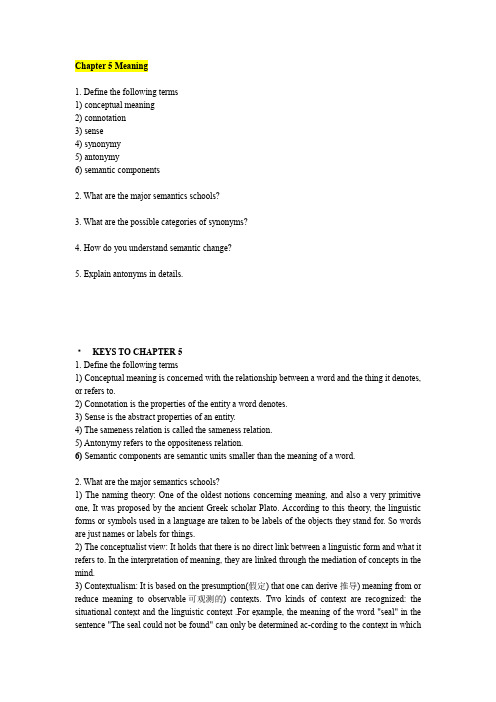
Chapter 5 Meaning1. Define the following terms1) conceptual meaning2) connotation3) sense4) synonymy5) antonymy6) semantic components2. What are the major semantics schools?3. What are the possible categories of synonyms?4. How do you understand semantic change?5. Explain antonyms in details.KEYS TO CHAPTER 51. Define the following terms1) Conceptual meaning is concerned with the relationship between a word and the thing it denotes, or refers to.2) Connotation is the properties of the entity a word denotes.3) Sense is the abstract properties of an entity.4) The sameness relation is called the sameness relation.5) Antonymy refers to the oppositeness relation.6) Semantic components are semantic units smaller than the meaning of a word.2. What are the major semantics schools?1) The naming theory: One of the oldest notions concerning meaning, and also a very primitive one, It was proposed by the ancient Greek scholar Plato. According to this theory, the linguistic forms or symbols used in a language are taken to be labels of the objects they stand for. So words are just names or labels for things.2) The conceptualist view: It holds that there is no direct link between a linguistic form and what it refers to. In the interpretation of meaning, they are linked through the mediation of concepts in the mind.3) Contextualism: It is based on the presumption(假定) that one can derive推导) meaning from or reduce meaning to observable可观测的) contexts. Two kinds of context are recognized: the situational context and the linguistic context .For example, the meaning of the word "seal" in the sentence "The seal could not be found" can only be determined ac-cording to the context in whichthe sentence occurs:4) BehaviorismThe contextualist view was further strengthened by Bloomfield. He drew on behaviorist psychology when he tried to define the meaning of linguistic forms. Behaviorists attempted to de-fine the meaning of a language form as " the situation in which the speaker utters it and the response it calls forth in the hearer". This behaviorist theory is somewhat close to contextualism. It is linked with psychological interest.3. What are the possible categories of synonyms?Synonymy can be divided into the following groups:Dialectal synonyms (地域性同义词): Dialectal synonyms are words which have more or less the same meaning and are used in different regional dialects such as petroleum in British English and gasoline in American English. Dialectal synonyms can also be found within British, or American English itself. For example, "girl" is called "lass" or "lassie" in Scottish dialect.Stylistic synonyms文体同义词): Stylistic synonyms are words which have the same meaning but differ in style, or degree of formality. Some of the stylistic synonyms tend to be more formal, others tend to be casual , and still others are neutral in style, for example, old man, daddy, dad, father, male parent.Synonyms that differ in their emotive or evaluative meaning :感性或评价方面不同的同义词They are words that have the same meaning but express different emotions of the user. The emotions of the user indicate the attitude or bias of the user toward what he is talking about, such as thrifty and miser.Collocational synonyms搭配上的区别的同义词): Some synonyms differ in their collocation. That is, they go together with different words, for example: accuse. . . of, charge. . . with, rebuke. .-for.Semantically different synonyms(语意上的差别): They refer to the synonyms that differ slightly in what they mean. For example, "amaze" and "astound" are very close in meaning to the word "surprise," but they have very subtle differences in meaning. While amaze suggests confusion and bewilderment, "astound" implies difficulty in believing.4. How do you understand semantic change?Semantic change refers to the change of meaning of a word. The major types of semantic change are as follows: (1) Semantic broadening refers to the process in which the meaning of a word becomes more general or inclusive than its historically earlier denotation. For example, the word “holiday” was originally used to mean a day of religious significance because it was a “holy day”. Today everyone enjoys a holiday, whether he or she is religious or not. (2) Semantic narrowing is the reverse process in which the meaning of a word becomes less general or inclusive than its historically earlier meaning. For example, the word “liquor” in contemporary English is an alcoholic drink, but it was once synonymous with “liquid”, be it alcoholi c or not. (3) Semantic shift refers to the process in which a word loses its former meaning and acquires a new, sometimes related meaning, e.g. the word “silly”. Quite surprisingly, a “silly” person was a happy person in Old English, and a naive person in Middle English, but a foolish person in Modern English.5. Explain antonyms in details.Antonymy refers to the oppositeness of meaning. Words that are opposite in meaning are called antonyms.1) Gradable antonyms渐进性关系反义: Some antonyms are gradable because there are often intermediate forms between the two members of a pair such as old/young, hot/cold.2) Complementary antonyms完全反义: a pair of complementary antonyms is characterized by the feature that the denial of one member of the pair implies the assertion of the other.3) Relational opposites相关对立反义: pairs of words that exhibit the reversal of a relationship between the two items.。
语言学笔记5说课材料

Chapter 5 Semantics一、定义1.命名论The naming theoryThe naming theory, one of the oldest notions concerning meaning, and also a very primitive onewas proposed by the ancient Greek scholar Plato. According to this theory, the linguistic forms orsymbols, in other words,the words used in a language are taken to be labels of the objects theystand for, so words are just names or labels for things.2.意念论The conceptualist viewIt holds that there is no direct link between a linguistic form and what it refers to; rather ,in theinterpretation of meaning they are linked through the mediation of concepts in the mind.3.语境论ConceptualismIt’s based on the presumption that one can derive meaning from or reduce meaning toobservable contexts. her are two kinds of context: the situational and the linguistic context.4.行为主义论BehaviorismIt refers to the attempted to define the meaning of a language form as the” situation in whicthis theory somewhat close tospeaker utters it and the response it calls forth in the hearer”.conceptualism emphasizes on the psychological response.5.意义Sensethe collection of all the concerned with the inherent meaning of the linguistic form. It’sIt’s-contextualized.features of the linguistic form, it’s abstract and de6.所指意义ReferenceIt means what a linguistic form refers to in the real, physical world, it deals with the relationshipbetween the linguistic element and the non-linguistic world of experience.7.同义词SynonymyIt refers to the sameness or close similarity of meaning or we can say that words are close inmeaning are called synonyms.8.多义词PolysemyIt refers to different words may have the same or similar meaning, the same one word may havemore than one meaning.9.同音(形)异义HomonymyIt refers to the phenomenon that words have different meanings have the same form, i.e,different words are identical in sound or spelling, or in both.10.同音异义HomophonesIt refers to two words are identical in sound. e.g. rain/reign.11.同形异义HomographsIt refers to two words are identical in form .e.g. tear v./tear n.12.上下义关系HyponymyIt refers to the sense relation between a more general, more inclusive word and a more specificword. the word which is more general in meaning is called superordinate, and the more specificwords are called its hyponyms.13.反义词AntonymyIt’s the term used for oppositeness of meaning on different dimension.14.成分分析法Componential Analysis----分析词汇抽象意义It’s a way proposed by the structural semanticists to analyz e word meaning.this approach is based upon the belief that meaning of a word can be dissected into meaning components, called semantic features.15.述谓结构分析Predication Analysis 由British Linguist G.Leech提出analysis.It’s a new approach for sentential meaningPredication is usually considered an important common category shared by propositions, questions, commands ect.通过对论元argument和谓语predicate的分析,达到对句子意义进行分析的许多模式中的一种。
简明英语语言学教程第二版课后参考答案
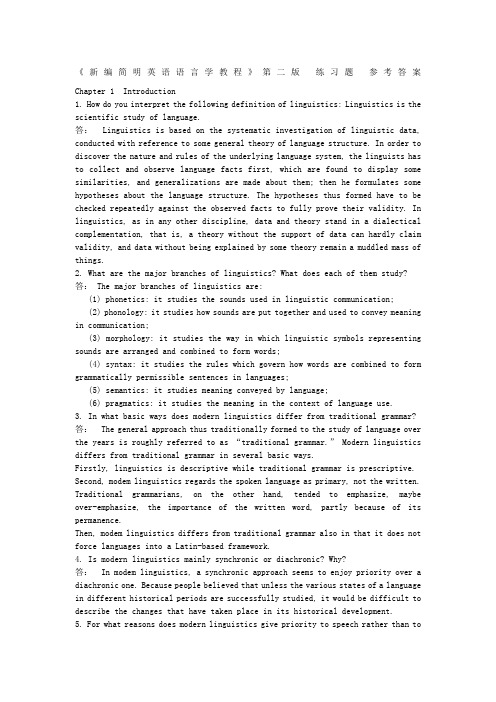
《新编简明英语语言学教程》第二版练习题参考答案Chapter 1 Introduction1. How do you interpret the following definition of linguistics: Linguistics is the scientific study of language.答: Linguistics is based on the systematic investigation of linguistic data, conducted with reference to some general theory of language structure. In order to discover the nature and rules of the underlying language system, the linguists has to collect and observe language facts first, which are found to display some similarities, and generalizations are made about them; then he formulates some hypotheses about the language structure. The hypotheses thus formed have to be checked repeatedly against the observed facts to fully prove their validity. In linguistics, as in any other discipline, data and theory stand in a dialectical complementation, that is, a theory without the support of data can hardly claim validity, and data without being explained by some theory remain a muddled mass of things.2. What are the major branches of linguistics? What does each of them study? 答: The major branches of linguistics are:(1) phonetics: it studies the sounds used in linguistic communication;(2) phonology: it studies how sounds are put together and used to convey meaning in communication;(3) morphology: it studies the way in which linguistic symbols representing sounds are arranged and combined to form words;(4) syntax: it studies the rules which govern how words are combined to form grammatically permissible sentences in languages;(5) semantics: it studies meaning conveyed by language;(6) pragmatics: it studies the meaning in the context of language use.3. In what basic ways does modern linguistics differ from traditional grammar? 答: The general approach thus traditionally formed to the study of language over the years is roughly referred to as “traditional grammar.” Modern linguistics differs from traditional grammar in several basic ways.Firstly, linguistics is descriptive while traditional grammar is prescriptive. Second, modem linguistics regards the spoken language as primary, not the written. Traditional grammarians, on the other hand, tended to emphasize, maybe over-emphasize, the importance of the written word, partly because of its permanence.Then, modem linguistics differs from traditional grammar also in that it does not force languages into a Latin-based framework.4. Is modern linguistics mainly synchronic or diachronic? Why?答: In modem linguistics, a synchronic approach seems to enjoy priority over a diachronic one. Because people believed that unless the various states of a language in different historical periods are successfully studied, it would be difficult to describe the changes that have taken place in its historical development.5. For what reasons does modern linguistics give priority to speech rather than towriting?答: Speech and writing are the two major media of linguistic communication. Modem linguistics regards the spoken language as the natural or the primary medium of human language for some obvious reasons. From the point of view of linguistic evolution, speec h is prior to writing. The writing system of any language is always “invented” by its users to record speech when the need arises. Even in today's world there are still many languages that can only be spoken but not written. Then in everyday communication, speech plays a greater role than writing in terms of the amount of information conveyed. And also, speech is always the way in which every native speaker acquires his mother tongue, and writing is learned and taught later when he goes to school. For modern linguists, spoken language reveals many true features of human speech while written language is only the “revised” record of speech. Thus their data for investigation and analysis are mostly drawn from everyday speech, which they regard as authentic.6. How is Saussure's distinction between langue and parole similar to Chomsky's distinction between competence and performance?答: Saussure's distinction and Chomsky's are very similar, they differ at least in that Saussure took a sociological view of language and his notion of langue is a matter of social conventions, and Chomsky looks at language from a psychological point of view and to him competence is a property of the mind of each individual.7. What characteristics of language do you think should be included in a good, comprehensive definition of language?答: First of all, language is a system, i.e., elements of language are combined according to rules.Second, language is arbitrary in the sense that there is no intrinsic connection between a linguistic symbol and what the symbol stands for.Third, language is vocal because the primary medium for all languages is sound. Fourth, language is human-specific, i. e., it is very different from the communication systems other forms of life possess.8. What are the main features of human language that have been specified by C. Hockett to show that it is essentially different from animal communication system?答:The main features of human language are termed design features. They include: 1) ArbitrarinessLanguage is arbitrary. This means that there is no logical connection between meanings and sounds. A good example is the fact that different sounds are used to refer to the same object in different languages.2) ProductivityLanguage is productive or creative in that it makes possible the construction and interpretation of new signals by its users. This is why they can produce and understand an infinitely large number of sentences, including sentences they have never heard before.3) DualityLanguage consists of two sets of structures, or two levels. At the lower or the basic level there is a structure of sounds, which are meaningless by themselves.But the sounds of language can be grouped and regrouped into a large number of units of meaning, which are found at the higher level of the system.4) DisplacementLanguage can be used to refer to things which are present or not present, real or imagined matters in the past, present, or future, or in far-away places. In other words, language can be used to refer to contexts removed from the immediate situations of the speaker. This is what “displacement” means.5) Cultural transmissionWhile human capacity for language has a genetic basis, i.e., we were all born with the ability to acquire language, the details of any language system are not genetically transmitted, but instead have to be taught and learned.9. What are the major functions of language? Think of your own examples for illustration.答: Three main functions are often recognized of language: the descriptive function, the expressive function, and the social function.The descriptive function is the function to convey factual information, which can be asserted or denied, and in some cases even verified. For example: “China is a large country with a long history.”The expressive function supplies information about the user’s feelings, preferences, prejudices, and values. For example: “I will never go window-shopping with her.”The social function serves to establish and maintain social relations between people. . For example: “We are your firm supporters.”Chapter 2 Speech Sounds1. What are the two major media of linguistic communication? Of the two, which one is primary and why?答: Speech and writing are the two major media of linguistic communication.Of the two media of language, speech is more primary than writing, for reasons, please refer to the answer to the fifth problem in the last chapter.2. What is voicing and how is it caused?答: Voicing is a quality of speech sounds and a feature of all vowels and some consonants in English. It is caused by the vibration of the vocal cords.3. Explain with examples how broad transcription and narrow transcription differ? 答: The transcription with letter-symbols only is called broad transcription. This is the transcription normally used in dictionaries and teaching textbooks for general purposes. The latter, i.e. the transcription with letter-symbols together with the diacritics is called narrow transcription. This is the transcription needed and used by the phoneticians in their study of speech sounds. With the help of the diacritics they can faithfully represent as much of the fine details as it is necessary for their purpose.In broad transcription, the symbol [l] is used for the sounds [l] in the four words leaf [li:f], feel [fi:l], build [bild], and health [helθ]. As a matter of fact, the sound [l] in all these four sound combinations differs slightly. The [l]in [li:f], occurring before a vowel, is called a dear [l], and no diacritic is needed to indicate it; the [1] in [fi:l] and [bild], occurring at the end of a word or before another consonant, is pronounced differently from the clear [1] as in “leaf”. It is called dark [?] and in narrow transcription the diacritic [?] is used to indicate it. Then in the sound combination [helθ], the sound [l] is followed by the English dental sound [θ], its pronunciation is somewhat affected by the de ntal sound that follows it. It is thus called a dental [l], and in narrow transcription the diacritic [、] is used to indicate it. It is transcribed as [helθ].Another example is the consonant [p]. We all know that [p] is pronounced differently in the two words pit and spit. In the word pit, the sound [p] is pronounced with a strong puff of air, but in spit the puff of air is withheld to some extent. In the case of pit, the [p] sound is said to be aspirated and in the case of spit, the [p] sound is unaspirated. This difference is not shown in broad transcription, but in narrow transcription, a small raised “h” is used to show aspiration, thus pit is transcribed as [ph?t] and spit is transcribed as [sp?t].4. How are the English consonants classified?答: English consonants can be classified in two ways: one is in terms of manner of articulation and the other is in terms of place of articulation. In terms of manner of articulation the English consonants can be classified into the following types: stops, fricatives, affricates, liquids, nasals and glides. In terms of place of articulation, it can be classified into following types: bilabial, labiodental, dental, alveolar, palatal, velar and glottal.5. What criteria are used to classify the English vowels?答: Vowels may be distinguished as front, central, and back according to which part of the tongue is held highest. To further distinguish members of each group, we need to apply another criterion, i.e. the openness of the mouth. Accordingly, we classify the vowels into four groups: close vowels, semi-close vowels, semi-open vowels, and open vowels. A third criterion that is often used in the classification of vowels is the shape of the lips. In English, all the front vowels and the central vowels are unfounded vowels, i. e., without rounding the lips, and all the back vowels, with the exception of [a:], are rounded. It should be noted that some front vowels can be pronounced with rounded lips.6. A. Give the phonetic symbol for each of the following sound descriptions:1) voiced palatal affricate2) voiceless labiodental fricative3) voiced alveolar stop4) front, close, short5) back, semi-open, long6) voiceless bilabial stopB. Give the phonetic features of each of the following sounds:1) [ t ] 2) [ l ] 3) [?] 4) [w] 5) [?] 6) [?]答:A. (1) [?] (2) [ f ] (3) [d ] (4) [ ? ] (5) [ ?:] (6) [p]B. (1) voiceless alveolar stop (2) voiced alveolar liquid(3) voiceless palatal affricate (4) voiced bilabial glide(5) back, close, short (6) front, open7. How do phonetics and phonology differ in their focus of study? Who do you think will be more interested in the difference between, say, [l] and [?], [ph] and [p], a phonetician or a phonologist? Why?答: (1) Both phonology and phonetics are concerned with the same aspect of language –– the speech sounds. But while both are related to the study of sounds,, they differ in their approach and focus. Phonetics is of a general nature; it is interested in all the speech sounds used in all human languages: how they are produced, how they differ from each other, what phonetic features they possess, how they can be classified, etc. Phonology, on the other hand, aims to discover how speech sounds in a language form patterns and how these sounds are used to convey meaning in linguistic communication.(2) A phonologist will be more interested in it. Because one of the tasks of the phonologists is to find out rule that governs the distribution of [l] and [?], [ph] and [p].8. What is a phone? How is it different from a phoneme? How are allophones related to a phoneme?答: A phone is a phonetic unit or segment. The speech sounds we hear and produce during linguistic communication are all phones. A phoneme is not any particular sound, but rather it is represented or realized by a certain phone in a certain phonetic context. The different phones which can represent a phoneme in different phonetic environments are called the allophones of that phoneme. For example, the phoneme /l/ in English can be realized as dark [?], clear [l], etc. which are allophones of the phoneme /l/.9. Explain with examples the sequential rule, the assimilation rule, and the deletion rule.答: Rules that govern the combination of sounds in a particular language are called sequential rules.There are many such sequential rules in English. For example, if a word begins with a [l] or a [r], then the next sound must be a vowel. That is why [lbik] [lkbi] are impossible combinations in English. They have violated the restrictions on the sequencing of phonemes.The assimilation rule assimilates one sound to another by “copying” a feature of a sequential phoneme, thus making the two phones similar. Assimilation of neighbouring sounds is, for the most part, caused by articulatory or physiological processes. When we speak, we tend to increase the ease of articulation. This “sloppy” tendency may become regularized as rules of language.We all know that nasalization is not a phonological feature in English, i.e., it does not distinguish meaning. But this does not mean that vowels in English are never nasalized in actual pronunciation; in fact they are nasalized in certain phonetic contexts. For example, the [i:] sound is nasalized in words like bean, green, team, and scream. This is because in all these sound combinations the [i:] sound is followed by a nasal [n] or [m].The assimilation rule also accounts for the varying pronunciation of thealveolar nasal [n] in some sound combinations. The rule is that within a word, the nasal [n] assumes the same place of articulation as the consonant that follows it. We know that in English the prefix in- can be added to ma adjective to make the meaning of the word negative, e.g. discreet – indiscreet, correct – incorrect. But the [n] sound in the prefix in- is not always pronounced as an alveolar nasal. It is so in the word indiscreet because the consonant that follows it, i.e. [d], is an alveolar stop, but the [n] sound in the word incorrect is actually pronounced as a velar nasal, i.e. [?]; this is because the consonant that follows it is [k], which is a velar stop. So we can see that while pronouncing the sound [n], we are “copying”a feature of the consonant that follows it.Deletion rule tells us when a sound is to be deleted although it is orthographically represented. We have noticed that in the pronunciation of such words as sign, design, and paradigm, there is no [g] sound although it is represented in spelling by the letter g. But in their corresponding forms signature, designation, and paradigmatic, the [g] represented by the letter g is pronounced. The rule can be stated as: Delete a [g] when it occurs before a final nasal consonant. Given the rule, the phonemic representation of the stems in sign –signature, resign –resignation, phlegm –phlegmatic, paradigm – paradigmatic will include the phoneme /g/, which will be deleted according to the regular rule if no suffix is added.10. What are suprasegmental features? How do the major suprasegmental features of English function in conveying meaning?答: The phonemic features that occur above the level of the segments are called suprasegmental features. The main suprasegmental features include stress, intonation, and tone. The location of stress in English distinguishes meaning. There are two kinds of stress: word stress and sentence stress. For example, a shift of stress may change the part of speech of a word from a noun, to a verb although its spelling remains unchanged. Tones are pitch variations which can distinguish meaning just like phonemes.Intonation plays an important role in the conveyance of meaning in almost every language, especially in a language like English. When spoken in different tones, the same sequence of words may have different meanings.Chapter 3 Morphology1. Divide the following words into their separate morphemes by placing a “+” between each morpheme and the next:a. microfile e. telecommunicationb. bedraggled f. forefatherc. announcement g. psychophysicsd. predigestion h. mechanist答:a. micro + file b. be + draggle + edc. announce + mentd. pre + digest + ione. tele + communicate + ionf. fore + fatherg. psycho + physics h. mechan + ist2. Think of three morpheme suffixes, give their meaning, and specify the types ofstem they may be suffixed to. Give at least two examples of each.Model: -orsuffix: -ormeaning: the person or thing performing the actionstem type: added to verbsexamples: actor, “one who acts in stage plays, motion pictures, etc.”translator, “one who translates”答:(1) suffix: -ablemeaning: something can be done or is possiblestem type: added to verbsexamples: acceptable, “can be accepted”respectable, “can be respected”(2) suffix: -lymeaning: functionalstem type: added to adjectivesexamples: freely. “adverbial form of ‘free’ ”quickly, “adverbial form of 'quick' ”.(3) suffix: -eemeaning: the person receiving the actionstem type: added to verbsexamples: employee, “one who works in a company”interviewee, “one who is interviewed”3. Think of three morpheme prefixes, give their meaning, and specify the types ofstem they may be prefixed to. Give at least two examples of each.Model: a-prefix: a-meaning: “without; not”stem type: added to adjectivesexamples: asymmetric, “lacking symmetry” asexual, “without sex or sexorgans”答:(1) prefix: dis-meaning: showing an oppositestem type: added to verbs or nounsexamples : disapprove, “do not approve”dishonesty, “lack of honesty”.(2) prefix: anti-meaning: against, opposed tostem type: added to nouns or adjectivesexamples : antinuclear, “opposing the use of atomic weapons and power”antisocial, “opposed or harmful to the laws and customs of anorganized community. ”(3) prefix: counter-meaning: the opposite ofstem type: added to nouns or adjectives.examples: counterproductive, “produc ing results opposite to those intended”counteract, “act against and reduce the force or effect of (sth.) ”4. The italicized part in each of the following sentences is an inflectional morpheme. Study each inflectional morpheme carefully and point out its grammatical meaning. Sue moves in high-society circles in London.A traffic warden asked John to move his car.The club has moved to Friday, February 22nd.The branches of the trees are moving back and forth.答:(1) the third person singular(2) the past tense(3) the present perfect(4) the present progressive5. Determine whether the words in each of the following groups are related to one another by processes of inflection or derivation.a) go, goes, going, goneb) discover, discovery, discoverer, discoverable, discoverabilityc) inventor, inventor’s, inventors, inventors’d) democracy, democrat, democratic, democratize答:(略)6. The following sentences contain both derivational and inflectional affixes. Underline all of the derivational affixes and circle the inflectional affixes.a) The farmer’s cows escaped.b) It was raining.c) Those socks are inexpensive.d) Jim needs the newer copy.e) The strongest rower continued.f) She quickly closed the book.g) The alphabetization went well.答:(略)Chapter 4 Syntax1. What is syntax?Syntax is a branch of linguistics that studies how words are combined to form sentences and the rules that govern the formation of sentences.2. What is phrase structure rule?The grammatical mechanism that regulates the arrangement of elements (i.e. specifiers, heads, and complements) that make up a phrase is called a phrase structure rule.The phrase structural rule for NP, VP, AP, and PP can be written as follows:NP → (Det) N (PP) ...VP → (Qual) V (NP) ...AP → (Deg) A (PP) ...PP → (Deg) P (NP) ...We can formulate a single general phrasal structural rule in which X stands for the head N, V, A or P.3. What is category? How to determine a word's category?Category refers to a group of linguistic items which fulfill the same or similar functions in a particular language such as a sentence, a noun phrase or a verb. To determine a word's category, three criteria are usually employed, namely meaning, inflection and distribution.若详细回答,则要加上:Word categories often bear some relationship with its meaning. The meanings associated with nouns and verbs can be elaborated in various ways. The property or attribute of the entities denoted by nouns can be elaborated by adjectives. For example, when we say that pretty lady, we are attributing the property ‘pretty’ to the lady designated by the noun. Similarly, the properties and attributes of the actions, sensations and states designated by verbs can typically be denoted by adverbs. For example, in Jenny left quietly the adverb quietly indicates the manner of Jenny's leaving.The second criterion to determine a word's category is inflection. Words of different categories take different inflections. Such nouns as boy and desk take the plural affix -s. Verbs such as work and help take past tense affix -ed and progressive affix -ing. And adjectives like quiet and clever take comparative affix -er and superlative affix -est. Although inflection is very helpful in determining a word's category, it does not always suffice. Some words do not take inflections. For example, nouns like moisture, fog, do not usually take plural suffix -s and adjectives like frequent, intelligent do not take comparative and superlative affixes -er and -est.The last and more reliable criterion of determining a word's category is its distribution. That is what type of elements can co-occur with a certain word. For example, nouns can typically appear with a determiner like the girl and a card, verbs with an auxiliary such as should stay and will go, and adjectives with a degree word such as very cool and too bright.A word's distributional facts together with information about its meaning and inflectional capabilities help identify its syntactic category.4. What is coordinate structure and what properties does it have?The structure formed by joining two or more elements of the same type with the help of a conjunction is called coordinate structures.It has (或写Conjunction exhibits) four important properties:1) There is no limit on the number of coordinated categories that can appear priorto the conjunction.2) A category at any level (a head or an entire XP) can be coordinated.3) Coordinated categories must be of the same type.4) The category type of the coordinate phrase is identical to the category typeof the elements being conjoined.5. What elements does a phrase contain and what role does each element play?A phrase usually contains the following elements: head, specifier and complement. Sometimes it also contains another kind of element termed modifier. The role each element can play:Head:Head is the word around which a phrase is formed.Specifier:Specifier has both special semantic and syntactic roles. Semantically, it helps to make more precise the meaning of the head. Syntactically, it typically marks a phrase boundary.Complement:Complements are themselves phrases and provide information about entities and locations whose existence is implied by the meaning of the head.Modifier:Modifiers specify optionally expressible properties of the heads.6. What is deep structure and what is surface structure?There are two levels of syntactic structure. The first, formed by the XP rule in accordance with the head's subcategorization properties, is called deep structure (or D-structure). The second, corresponding to the final syntactic form of the sentence which results from appropriate transformations, is called surface structure (or S-structure).(以下几题只作初步的的成分划分,未画树形图, 仅供参考)7. Indicate the category of each word in the following sentences.a) The old lady got off the bus carefully.Det A N V P Det N Advb) The car suddenly crashed onto the river bank.Det N Adv V P Det Nc) The blinding snowstorm might delay the opening of the schools. Det A N Aux V Det N P Det Nd) This cloth feels quite soft.Det N V Deg A8. The following phrases include a head, a complement, and a specifier. Draw the appropriate tree structure for each.a) rich in mineralsXP(AP) → head (rich) A + complement (in minerals) PPb) often read detective storiesXP(VP) →specifier (often) Qual + head (read) V + complement (detective stories) NPc) the argument against the proposalsXP(NP) →specifier (the) Det + head (argument) N + complement (against the proposals) PPd) already above the windowXP(VP) →specifier (already) Deg + head (above) P + complement (the window)NPd) The apple might hit the man.S →NP (The apple) + Infl (might) + VP (hit the man)e) He often reads detective stories.S →NP (He) + VP (often reads detective stories)9. The following sentences contain modifiers of various types. For each sentence, first identify the modifier(s), then draw the tree structures.(斜体的为名词的修饰语,划底线的为动词的修饰语)a) A crippled passenger landed the airplane with extreme caution.b) A huge moon hung in the black sky.c) The man examined his car carefully yesterday.d) A wooden hut near the lake collapsed in the storm.10. The following sentences all contain conjoined categories. Draw a tree structure for each of the sentences.(划底线的为并列的范畴)a) Jim has washed the dirty shirts and pants.b) Helen put on her clothes and went out.c) Mary is fond of literature but tired of statistics.11. The following sentences all contain embedded clauses that function as complements of a verb, an adjective, a preposition or a noun. Draw a tree structure for each sentence.a) You know that I hate war.b) Gerry believes the fact that Anna flunked the English exam.c) Chris was happy that his father bought him a Rolls-Royce.d) The children argued over whether bats had wings.12. Each of the following sentences contains a relative clause. Draw the deep structure and the surface structure trees for each of these sentences.a) The essay that he wrote was excellent.b) Herbert bought a house that she lovedc) The girl whom he adores majors in linguistics.13. The derivations of the following sentences involve the inversion transformation. Give the deep structure and the surface structure of each of these sentences. (斜体的为深层结构,普通字体的为表层结构)a) Would you come tomorrow?you would come tomorrowb) What did Helen bring to the party?Helen brought what to the partyc) Who broke the window?who broke the window。
新编简明英语语言学教程ch5PPT课件

The inherent meaning of the linguistic form. It is the collection of all the features of the linguistic form; It’s abstract and de-contextualized. It’s the aspect of meaning dictionary compilers are interested in. It is concerned with the intralinguistic relations.
Jill
Jack
S_________r--------s_________R
When Jill sees an apple and wants to have it, she has a physical Stimulus, ….
5.3 Lexical meaning
5.3.1 Sense and reference Sense
i. Dialectal synonyms — synonyms used in different regional dialects
British English autumn lift luggage lorry petrol flat windscreen torch
新编简明英语语言学教程ch5
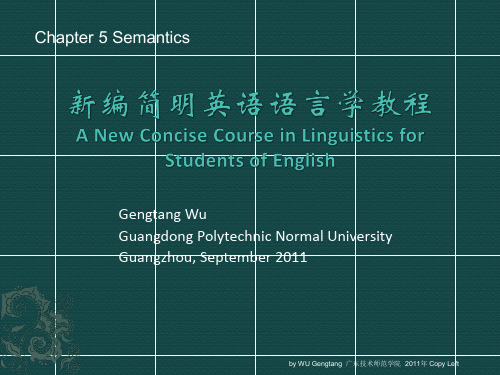
Synonymy
the sameness or close similarity of meaning
i. Dialectal synonyms — synonyms used in different regional dialects
a view of the nature of the meaning and reference of proper names generally attributed to Gottlob Frege and Bertrand Russell. The theory consists essentially in the idea that the meanings (semantic contents) of names are identical to the descriptions associated with them by speakers, while their referents are determined to be the objects that satisfy these descriptions.
② Complementary antonymy
It is characterized by the feature that the denial of one member of the pair implies the assertion of the other and the assertion of one means the denial of the other.
by WU Gengtang 广东技术师范学院 2011年 Copy Left
新编简明英语语言学教程05Chapter-5-semantics
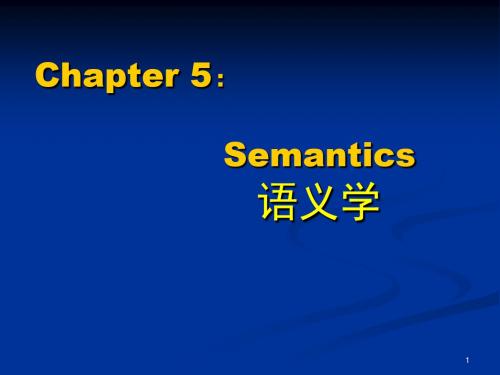
16
Note:
Linguistic forms having the same sense may have different references in different situations; on the other hand, there are also occasions, when linguistic forms with the same reference might differ in sense, e.g. the morning star and the evening star,
用符号或单词表示物体是通过言语者思 维中单词的形式与概念联系起来实现的。 从这个观点看,概念就是单词的意义。
9
Contextualism (语境论)
Meaning should be studied in terms of situation, use, context — elements closely linked with language behavior.
3
Naming theory (Plato)命名论
Words are names or labels for things.
词语只是代表物体的名字或标记。
Limitations:
1) Applicable to nouns only.
2) There are nouns which denote things that do not exist in the real world, e.g. ghost, dragon, unicorn, phenix…
新编简明英语语言学教程05Chapter5-sema

"up" and "down", "hot" and "cold".
examples
understanding antonyms helps to express contrasts and nuances more accurately.
importance
antonymy
examples
"John opened the door." (John 是动作 "open" 的发起者)
Agency example
Agency
Suffering from trouble
表示遭受某种困难或不幸,通常由动词或动词短语表示。
Suffering from trouble example
"The company is suffering from financial trouble." (公司正在遭受财务困难)
Types of semantic fields
The Application of Semantic Field Theory
Lexicography: Semantic field theory can be used in lexicography to organize and categorize words in dictionaries and thesauri based on their semantic relationships.
01
02
03
04
Point to the matter
05
CHAPTER
Semantic implication and presupposition
语言学5._Meaning
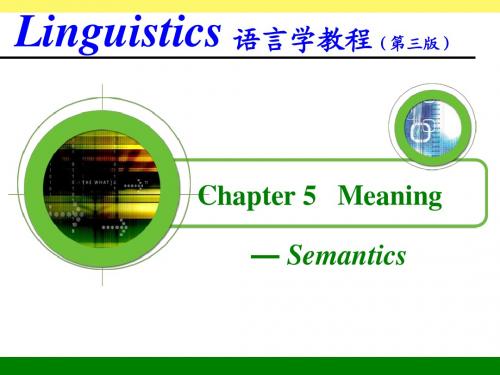
2015/12/14 2
Teaching Procedures
1. Introduction 2. Meanings of ―meaning‖ 3. Lexical meaning 3.1 Sense and reference 3.2 Major sense relations 3.3 Componential analysis 4. Sense relations between sentences 4.1 An integrated theory 4.2 Logical semantics 5. Task
Teaching difficulties: sense relations between sentences,
different types of antonymy
Teaching Methods & Strategies:
teacher presentation and class discussion
2015/12/14
10
Guess:
What does ‗cornea’ mean?
• The transparent, convex, anterior portion of the outer fibrous coat of the eyeball that covers the iris and the pupil and is continuous with the sclera.
- 1、下载文档前请自行甄别文档内容的完整性,平台不提供额外的编辑、内容补充、找答案等附加服务。
- 2、"仅部分预览"的文档,不可在线预览部分如存在完整性等问题,可反馈申请退款(可完整预览的文档不适用该条件!)。
- 3、如文档侵犯您的权益,请联系客服反馈,我们会尽快为您处理(人工客服工作时间:9:00-18:30)。
分间的关系。)
6
5.2 Word Classes and Word Order ①The boy kicked the ball angrily.
② Boy the ball kicked angrily. ③ The girl caught the boy angrily. ④ The flower smiles happily.
5
Syntax (句法)
—a branch of linguistics that studies how words are combined to form sentences and the rules that govern the formation of sentences.
(---a branch of linguistics that studies how words are combined to form sentences and the rules that govern the formation of sentences.
2
A finite clause(限定性分句) has a finite verb. A finite verb has tense. E.g.: “I run daily.” A non-finite clause(非限定性分句) has a verb without tense. E.g.: "...to run daily..."
4
The word syntax, derived originally from Greek, is made up of two morphemes: syn “together”, and tax “to arrange”, hence the literal meaning “a setting out together” or “arrangement”. In linguistics, it refers to the study of the rules governing the way words are combined to form sentences in a language, or the study of the formation of sentences.
8
Positional relation or word order (syntagmatic relation 组合关系) refers to the sequential arrangement of words in a language. If the words in a sentence fail to occur in a fixed order required by the convention of language, the sentence will be ungrammatical or nonsensical.
Which are grammatical and which are not, and why? Determiner + noun + verb + determiner+ noun + adv The dog ate the bone noisily. The boy kicked the ball angrily.
3
Examples:
1) I hurried home.
( a sentence, also a clause, a simple sentence)
2) John likes linguistics, but Mary is interested in history.
coordinating conjunction
7
Syntactic relations
(句法关系)
Syntactic relations can be analyzed into three kinds: – relations of position – relations of substitutability – relations of co-occurrence
(coordinate sentence/compound sentence)
3) Because I was late, they went without me.
subordinator subordinate clause (从属句) main clause(独立句,主句)
complex sentence
1
Clause can be classified into FINITE(限定 性) and NON-FINITE(非限定性) clauses, the latter including the traditional infinitive phrase, participial phrase, and gerundial phrase.
Traditionally a verb, e.g. in Latin or Greek, inflected for ‘person’ and ‘number’. Now more generally of any verb whose form is such that it can stand in a simple declarative sentence.
Chapter 5 Grammar: Clause
5.1 Introduction
Clause (小句/子句) —a group of words which form a grammatical unit and which contain a subject and a finite verb. A clause forms a sentence or part of a sentence and often funtive or adverb.
